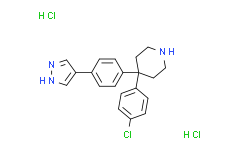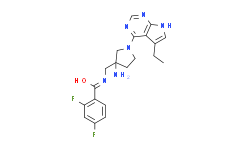| 中文名称: | AT7867 dihydrochloride | ||||
|---|---|---|---|---|---|
| 英文名称: | AT7867 dihydrochloride | ||||
| 别名: | AT7867 dihydrochloride AT7867 dihydrochloride | ||||
| CAS No: | 1431697-86-7 | 分子式: | C20H22Cl3N3 | 分子量: | 410.77 |
| CAS No: | 1431697-86-7 | ||||
| 分子式: | C20H22Cl3N3 | ||||
| 分子量: | 410.77 | ||||
基本信息
|
产品编号: |
A12286 |
||||
|
产品名称: |
AT7867 dihydrochloride |
||||
|
CAS: |
1431697-86-7 |
储存条件 |
粉末 |
-20℃ |
四年 |
|
|
|
||||
|
分子式: |
溶于液体 |
-80℃ |
6个月 |
||
|
分子量: |
410.77 |
-20℃ |
1个月 |
||
|
化学名: |
4-(4-Chlorophenyl)-4-[4-(1H-pyrazol-4-yl)phenyl]piperidine dihydrochloride |
||||
|
Solubility (25°C): |
|||||
|
体外:
|
DMSO |
|
|||
|
Ethanol |
|
||||
|
Water |
|
||||
|
体内(现配现用): |
|
||||
|
<1mg/ml表示微溶或不溶。 |
|||||
|
普西唐提供的所有化合物浓度为内部测试所得,实际溶液度可能与公布值有所偏差,属于正常的批间细微差异现象。 |
|||||
|
请根据产品在不同溶剂中的溶解度选择合适的溶剂配制储备液;⼀旦配成溶液,请分装保存,避免反复冻融造成的产品失效。 |
|||||
制备储备液
|
浓度
溶液体积 质量 |
1mg |
5mg |
10mg |
|
1mM |
2.4345mL |
12.1723mL |
24.3445mL |
|
5mM |
0.4869mL |
2.4345mL |
4.8689mL |
|
10mM |
0.2434mL |
1.2172mL |
2.4345mL |
生物活性
|
产品描述 |
一种ATP竞争性的Akt1/Akt2/Akt3和p70S6K/PKA抑制剂 |
|||
|
靶点 |
Akt1 32nM (IC50) |
Akt2 17nM (IC50) |
Akt3 47nM (IC50) |
PKA 20nM (IC50) |
|
体外研究 |
The inhibition of AKT2 by AT7867 is shown to be ATP-competitive with a Ki of 18nM.AT7867 also displays potent activity against the structurally related AGC kinases p70S6K and PKA,but shows a clear window of selectivity against kinases from other kinase sub-families.In vitro growth inhibition studies show that AT7867 blocks proliferation in a number of human cancer cell lines.AT7867 appears to be most potent at inhibiting proliferation in MES-SA uterine,MDA-MB-468 and MCF-7 breast,and HCT116 and HT29 colon lines (IC50 values range from 0.9-3μM),and least effective in the two prostate lines tested (IC50 values range from 10-12μM). |
|||
|
体内研究 |
Following oral administration at 20mg/kg,the elimination of AT7867 from plasma appears to be similar to that observed after i.v.administration.Plasma levels of AT7867 remain above 0.5μM for at least 6 hours following an oral dose of 20mg/kg.Assuming linear pharmacokinetics following i.v.administration,the bioavailability by the oral route is calculated to be 44%.In vivo pharmacodynamic (PD) biomarker studies are therefore performed with this model.Following pharmacokinetic and tolerability studies,doses of AT7867 (90mg/kg p.o.or 20mg/kg i.p.) are administered to athymic mice bearing MES-SA tumors and the phosphorylation status of GSK3βand S6RP in tumors is monitored over time.Clear inhibition of phosphorylation of the two markers of pathway activity is seen at 2 and 6 hours following treatment with AT7867.By 24 hours,total levels of both GSK3β and S6RP are greatly reduced. |
|||
推荐实验方法(仅供参考)
|
激酶实验: |
|
Kinase assays for AKT2,PKA,p70S6K and CDK2/cyclinA are all carried out in a radiometric filter binding format.Assay reactions are set up in the presence of compound.For AKT2,the AKT2 enzyme and 25μM AKTide-2T peptide (HARKRERTYSFGHHA) are incubated in 20mM MOPS,pH 7.2,25mM β-glycerophosphate,5mM EDTA,15mM MgCl2,1mM sodium orthovanadate,1mM DTT,10μg/mL BSA and 30μM ATP (1.16 Ci/mmol) for 4 hours.For PKA,the PKA enzyme and 50μM peptide (GRTGRRNSI) are incubated in 2mM MOPS,pH 7.2,25mM β-glycerophosphate,5mM EDTA,15mM MgCl2,1mM orthovanadate,1mM DTT and 40μM ATP (0.88 Ci/mmol) for 20 minutes.For p70S6K,the p70S6K enzyme and 25μM peptide substrate (AKRRRLSSLRA) are incubated in 10mM MOPS,pH 7,0.2mM EDTA,1mM MgCl2,0.01% βmercaptoethanol,0.1mg/mL BSA,0.001% Brij-35,0.5% glycerol and 15μM ATP (2.3 Ci/mmol) for 60 minutes.For CDK2,the CDK2/cyclinA enzyme and 0.12μg/ml Histone H1 are incubated in 20mM MOPS,pH 7.2,25mM β-glycerophosphate,5mM EDTA,15mM MgCl2,1mM sodium orthovanadate,1mM DTT,0.1mg/ml BSA and 45μM ATP (0.78 Ci/mmol) for 4 hours.Assay reactions are stopped by adding an excess of orthophosphoric acid and the stopped reaction mixture is then transferred to Millipore MAPH filter plates and filtered.The plates are then washed, scintillant added and radioactivity measured by scintillation counting on a Packard TopCount.IC50 values are calculated from replicate curves using GraphPad Prism software.AKT1 and 3 enzyme assays are carried out,while all other enzyme assays are performed. |
|
细胞实验: |
|
|
Cells are plated in 96-well microplates at 16,000 cells per well in medium supplemented with 10% FBS,and grown for 24 hours before treatment with AT7867.AT7867 or vehicle control are added to the cells for 1 hour.Following this,cells are fixed with 3% paraformaldehyde,0.25% glutaraldehyde,0.25% Triton-X100,washed and blocked with 5% milk in trisbuffered saline with 0.1% Tween-20 (TBST) prior to overnight incubation with a phospho-GSK3β(serine 9) antibody.The plates are then washed,secondary antibody added,and enhancement of the signal performed using DELFIA reagents.Europium counts are normalized to the protein concentration,and the IC50 value for each inhibitor is calculated in GraphPad Prism using non-linear regression analysis and a sigmoidal dose-response (variable slope) equation. |
|
|
动物实验: |
|
|
Mice Male athymic BALB/c mice (nu/nu) are used.A single dose of AT7867 is administered to BALB/c mice at 5mg/kg intravenously (i.v.) and 20mg/kg per os (p.o.).Plasma samples are collected from duplicate animals at each of the following time points;0.083,0.167,0.33,0.67,1,2,4,6,16 and 24 hours following i.v.dosing and at 0.25,0.5,1,2,4,6 and 24 hours following p.o.dosing.Mice are bled by cardiac puncture and all blood samples are centrifuged to obtain plasma,which is then frozen at -20℃ until analysis.For bioanalysis,all plasma samples are prepared by protein precipitation with acetonitrile containing internal standard.Quantification of sample extracts is by comparison with a standard calibration line constructed with AT7867 and using an inhibitor specific liquid chromatography tandem mass spectrometry (LC-MS/MS) method.Pharmacokinetic parameters are determined. |
|
本计算器可帮助您计算出特定溶液中溶质的质量、溶液浓度和体积之间的关系,公式为:
质量 (g) = 浓度 (mol/L) x 体积 (L) x 分子量 (g/mol)
摩尔浓度计算公式
用本工具协助配置特定浓度的溶液,使用的计算公式为:
开始浓度 x 开始体积 = 最终浓度 x 最终体积
稀释公式
稀释公式一般简略地表示为:C1V1 = C2V2 ( 输入 输出 )









